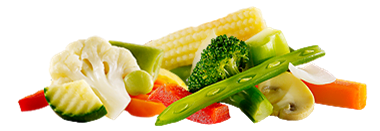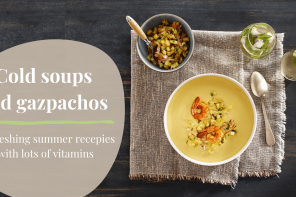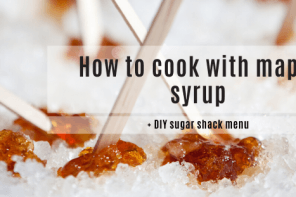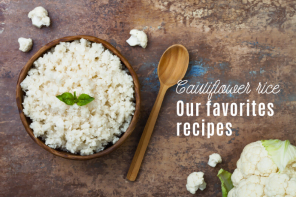Which food do Canadian families appreciate the most? Pasta! Whether you call it pasta or noodles, they’re the food of choice for busy weeknights, rich family meals or candlelit dinners. Learn more on this favourite food that pleases all palates!
Pasta in a nutshell


Do you know all the kinds of pasta?
Linguini, farfalle, ravioli, tortelloni, fusilli, fettuccini… We’re quickly losing our Latin with all the varieties of noodles available on the market! Arctic Gardens has prepared an article on the most popular types of pasta and the sauces they’re served with.
Lasagna: comforting and nourishing
 Lasagna is a type of ribbon pasta used to cook the dish of the same name. Two variations of this noodle exist: lasagnette (thinner lasagna) and lasagnotta (longer lasagna). What distinguishes this variety from others is that it’s cooked in layers! It marries well with meat and veggie sauces, béchamel, hard cheeses, and creamy cheeses like ricotta. All you need to make a lasagna is a little inspiration and creativity! Discover tons of ideas to make the best lasagna dishes and tricks to make them more quickly.
Lasagna is a type of ribbon pasta used to cook the dish of the same name. Two variations of this noodle exist: lasagnette (thinner lasagna) and lasagnotta (longer lasagna). What distinguishes this variety from others is that it’s cooked in layers! It marries well with meat and veggie sauces, béchamel, hard cheeses, and creamy cheeses like ricotta. All you need to make a lasagna is a little inspiration and creativity! Discover tons of ideas to make the best lasagna dishes and tricks to make them more quickly.
Fettuccini: Alfredo’s faves
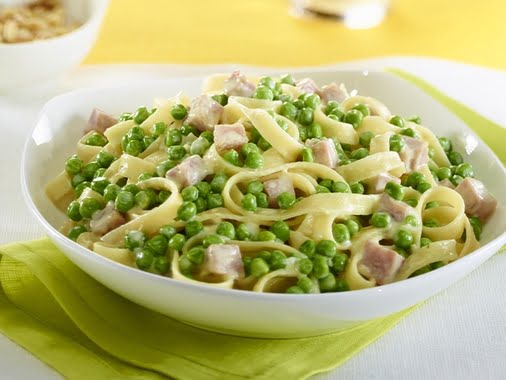 Like other ribbon pasta (tagliatelle, linguine, etc.), fettuccini is delicious with cream sauces like the classic fettuccini Alfredo. It also marries well with an olive oil base and a mix of vegetables (tomatoes, asparagus, spinach, peppers…) to which you can also add shrimp and basil to elevate it all! You’d like to prepare a delicious fettuccini Alfredo quickly? Discover our recipe!
Like other ribbon pasta (tagliatelle, linguine, etc.), fettuccini is delicious with cream sauces like the classic fettuccini Alfredo. It also marries well with an olive oil base and a mix of vegetables (tomatoes, asparagus, spinach, peppers…) to which you can also add shrimp and basil to elevate it all! You’d like to prepare a delicious fettuccini Alfredo quickly? Discover our recipe!
Spaghetti: A family classic
 There’s nothing more comforting that a good, homemade spaghetti and meat sauce! Try our version to put on top of your pasta. But if you want something different, spaghetti goes well with pesto, tomatoes and other vegetable sauces. A touch of parmesan should make the whole dish even more delicious! And that goes for spaghettini, (thinner spaghetti), vermicelli, (thinner spaghettini) and capellini (angel hair pasta).
There’s nothing more comforting that a good, homemade spaghetti and meat sauce! Try our version to put on top of your pasta. But if you want something different, spaghetti goes well with pesto, tomatoes and other vegetable sauces. A touch of parmesan should make the whole dish even more delicious! And that goes for spaghettini, (thinner spaghetti), vermicelli, (thinner spaghettini) and capellini (angel hair pasta).
Macaroni: the most popular
 Your macaroni will be exquisite with golden, melted cheese on top and in salads. For your cheesy casseroles, add broccoli, cauliflower and even asparagus to enhance the dish. Opt for a classic family macaroni salad with ham and mayo! You can also use it to make Chinese-style macaroni and the popular mac and cheese.
Your macaroni will be exquisite with golden, melted cheese on top and in salads. For your cheesy casseroles, add broccoli, cauliflower and even asparagus to enhance the dish. Opt for a classic family macaroni salad with ham and mayo! You can also use it to make Chinese-style macaroni and the popular mac and cheese.
Farfalle: funny and flexible
Your kids will love the funny shape! Farfalle in Italian means butterfly which describes really well the look of this noodle. Use farfalle with meat or vegetable sauces that simmer for a long time like macaroni. Or use it in salads. For a more comforting dish, coat it in a sauce with Italian sausage. For a salad bursting with freshness, go Greek: farfalle, fresh tomatoes, olives, crumbled feta and olive oil. It’s great for lunches!
Penne: Overflowing with flavour
 Use penne like farfalle: put it in rich sauces like carbonara or in salads. What’s great about this kind of pasta is that the sauce and sides really coat the noodles because of the hole in the centre of the pasta where it’ll stay. Discover our creamy spinach and chicken penne where every bite is overflowing with flavour! It comes in different sizes and there’s also penne rigate that are ridged. Choose according to your taste!
Use penne like farfalle: put it in rich sauces like carbonara or in salads. What’s great about this kind of pasta is that the sauce and sides really coat the noodles because of the hole in the centre of the pasta where it’ll stay. Discover our creamy spinach and chicken penne where every bite is overflowing with flavour! It comes in different sizes and there’s also penne rigate that are ridged. Choose according to your taste!
Fusilli and rotini: curly deliciousness
In the shape of a spiral, these pastas put originality and diversity on the plate which makes them all the rage with kids! Like penne, fusilli and rotini have small cavities where sauce and toppings get stuck. Cook them like penne: in rich and creamy sauces. Enough to make your mouth water!
Conchiglia: stuffed shells without restraint

Conchiglia is pasta shaped like a shell. It comes in several sizes and are stuffed and served on a bed of sauce. For the stuffing, ricotta and spinach are the items of choice. Ever had them? Try our shells in rosé sauce recipe that’s sure to win you over!
Tortelloni and ravioli: small package, big surprise

Tortelloni and ravioli are pasta filled with veggies, meat (sausage or ground meat) and of course, cheese. Choose fresh pasta to avoid overcooking the filling. Then coat it tomato or rosé sauce.
Whether you choose one or the other, be creative and daring. Who knows? Maybe you’ll discover something new and fresh!
Why do we like pasta so much?
Young and old alike, everyone loves pasta, so there’s got to be a reason! Here are just a few that will convince you that pasta is your best friend in the kitchen!
It’s easy for kids to eat
Noodles are a food of choice for babies starting to eat solid food. It’s easy for small hands to manipulate and they have a light taste and soft texture that make them easy to chew.
It’s quick and easy to prepare
Whether or not you’re comfortable in the kitchen, anyone can cook noodles. It’s probably the first meal you learned to make! Besides being delicious, pasta is a quick and easy dish to prepare. What more could you ask for?
It’s versatile
Carbonara, marina, bolognese, alfredo, primavera, in salads… There are a thousand and one ways to make pasta. Meat lovers and vegetarians like it because there’s something for everyone!
It comes in all shapes and sizes
Butterflies (farfalle), spirals (fusilli) or shells on the plate – they’re fun for kids and grownups! There are few foods that come in a multitude of shapes and sizes. This gives us lots of options to diversify dishes, so it’s easier to break the routine.
Is pasta healthy?
We often hear that pasta is unhealthy, that it makes you gain weight, that they’re full of calories. In short, it’s got a bad rap. The recommended serving of pasta is 1 cup for adults and ½ cup for kids. One serving contains as little fat as two store-bought chips! As well, calorie intake and carbohydrate content are similar to other starches (potatoes and rice), with the exception of whole wheat pasta that stands out because it has fewer calories. Pasta contains carbohydrates that our body needs, so we shouldn’t deny ourselves! The important thing is to watch serving sizes and to respect your hunger.
What makes pasta less healthy is what we put on top: butter, cheese, fresh cream, meat, etc., so watch your toppings – they’re the culprits! Here are a few tips to make your pasta dishes healthier:
- Replace butter with olive oil in your recipes
- Decrease the amount of cheese or choose lower fat cheese
- Opt for lean meat (turkey, chicken, extra lean ground meat, etc.)
- Add more veggies
In short, if you want a plate of healthy pasta, respect the recommended serving sizes, choose whole wheat pasta and add lighter sauces.
Is there such thing as gluten-free pasta?
People who are sensitive or allergic to gluten (celiac disease) have to be careful because pasta is made with semolina flour and this contains a lot of gluten. The food industry has developed noodles made from rice or corn flour to respond to this new challenge. Some brands of dry pasta now have gluten-free products. If you decide to make your homemade gluten-free pasta, just replace the whole wheat flour with rice or corn flour.
If you want more nutritional value or gluten-free pasta, there is a wide selection available in all supermarkets.
Dry pasta vs fresh pasta
Dry pasta at the grocery store is composed of less than 12% moisture whereas it’s up to about 30% for fresh. Their nutritional value is more or less the same, but what sets the two apart is their taste (and their price!).
If you’re ambitious, you can make your own pasta. It’s a lot of work, but worth it! As well, you can choose the flour you prefer, so you can make whole wheat, gluten-free, omega-3 pasta, etc.
For even cooking, use a large pot and add the pasta only when the water has come to a rolling boil. Stir the noodles right away so they don’t stick together. Pay attention as fresh pasta takes less time to cook than dry!

If the noodles are overcooked, they’ll probably taste like water. If you want the sauce to adhere to the pasta, don’t rinse it.
Fresh, uncooked pasta will keep in the fridge for 2 to 3 days whereas dry pasta will keep for about a year in an airtight container. In either case, the better they taste, the faster they’ll be gobbled up quickly!
“Vegetize“ your pasta
Dare to add veggies to your pasta recipes. They’ll add colour, taste and texture to your dishes! Asparagus, spinach, tomatoes and mushrooms go well with almost any plate of pasta. Don’t limit your choices to veggies – be creative. Culinary discoveries often come from experimenting!
Here are a few quick and useful recipes where veggies are the star:
Herb and Snach linguine Cauliflower Alfredo pasta
Avocado Alfredo Creamy pasta vegetables salad
Pasta Primavera Sun dried tomatoes pasta
San Francisco Casserole Pasta and Vegetables with Prosciutto
Vegetable lasagna Grilled Vegetables Pasta Salad
Macaroni casserole with meat and vegetables
Now let’s get cooking! It’s time to make a delicious bowl of pasta. There’s lot of inspiration here. Tell us which is your favourite pasta recipe!




